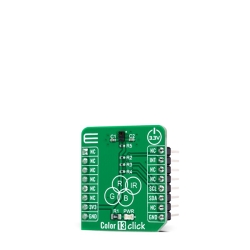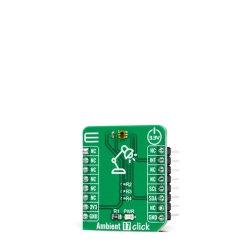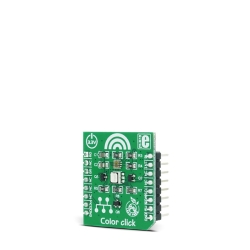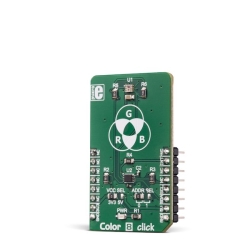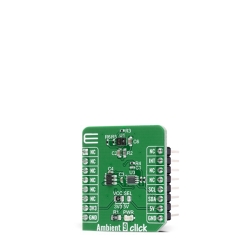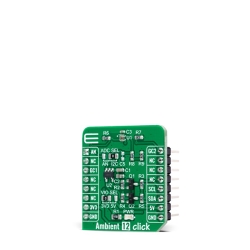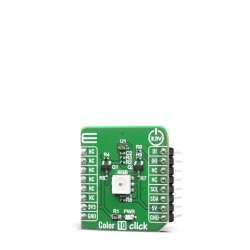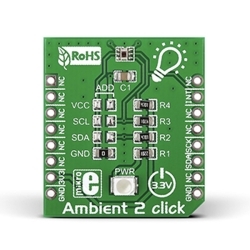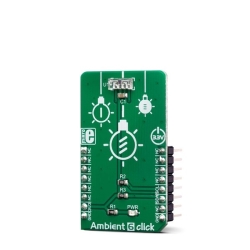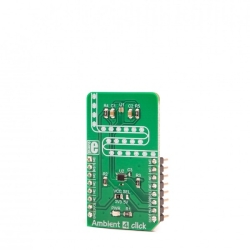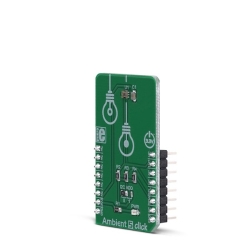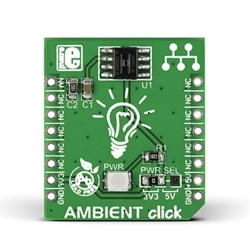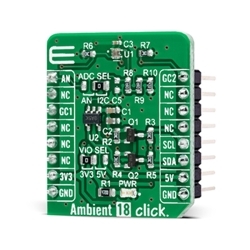MIKROE Ambient 8 Click
Ambient 8 Click is equipped with the ambient light sensor (ALS) IC, providing measurements of the ambient light intensity in a digital format.
Product Overview
Ambient 8 Click is equipped with the ambient light sensor (ALS) IC, providing measurements of the ambient light intensity in a digital format. It utilizes the LTR-329ALS-01, an ALS with the I2C interface. Packed in a small transparent ChipLED package, this sensor can provide very accurate readings: thanks to a 16-bit and resolution and high dynamic range, it can be used in both very dim and very bright lighting conditions: it can cover the range from 0.01 lx to 64 klx. It has an excellent IR filtering and two photo-sensing elements, allowing linear response over the whole range. The flicker noise rejection algorithm further improves accuracy, while excellent thermal compensation ensures consistency of the measurement results.
Ambient 8 Click is supported by a mikroSDK compliant library, which includes functions that simplify software development.
The LTR-329ALS-01 offers six programmable gain settings, ranging from 1x up to 96x. This allows operating flexibility, as the sensor can be used in both very bright and very dim environments. Ambient 8 Click can be used for a rapid development of various cost-effective applications that rely on light intensity sensing, including optical switches, backlight dimming applications for mobile and handheld devices, light metering applications (lux meters), and similar.
The main component of the Ambient 8 Click is the LTR-329ALS-01, a high accuracy ambient light sensor (ALS) with I2C interface, from LiteOn. This sensor has an excellent IR filtering capability, offering a spectral response similar to a response of a human eye. By utilizing two sensitive photo-diodes (PDs), of which one is sensitive to IR light only, the ALS IC is able cancel out the effect of the IR light spectrum. The dynamic range for the ambient light sensor is very large, starting down from 0.01 lx up to about 64 klx. Besides two PDs, the IC incorporates a temperature compensation, and a logic section with the I2C interface. A high dynamic range along with a linear response over the entire range, allows this sensor to be placed behind a dark glass or panels made of other semi-transparent materials.
The LTR-329ALS-01 sensor uses a set of configuration registers, which allow very simple operation. By default, the ALS sensor is set to the standby mode. It does not perform any conversions until set up in the active mode. The Click board™ is supported by the mikroSDK compatible library, which simplifies the development by offering simple functions. However, more detailed explanation of each register and its function can be found in the datasheet of the LTR-329ALS-01.
There is also a set of four 8-bit output registers, which contain the conversion data from both PDs. Once the firmware starts reading their value, all four output registers will become locked, preventing any further changes. This allows for data consistency during the I2C reading sequence. There is also a status register, which indicates availability of new conversion data at the output registers. The output data is in LSB/MSB format, 16-bit value which is spread across two 8-bit registers.
There are two parameters that affect the overall sensing speed and the output rate: the LTR-329ALS-01 allows to set up both the integration time, and the measurement rate. The integration time improves the noise and the accuracy at the cost of reduced output data rate, while the measurement rate is the rate at which the measurements are made. The maximum value of the integration time is 350ms, while the slowest measurement rate is 2 seconds.
A selectable sensitivity allows a very wide dynamic range for the ALS measurement. There are three sensitivity bits, allowing the sensitivity to be set to six different values: 1x, 2x, 4x, 8x, 48x, and 96x. This offers six different luminosity ranges to be covered. When the gain is set to 1x, the ALS sensor can read the whole range from 1 lx up to 65535 lx (1 lx/LSB sensitivity). By increasing the gain setting, the resolution is increased, but the upper measurement limit is reduced. For example, gain 2x will reduce the maximum value to 32768 lx, resulting with 0.5 lx/LSB.
The Click board™ is supported by the mikroSDK library, which contains functions for simplified development. The mikroSDK functions are well-documented, but there is still a need, the datasheet of the LTR-329ALS-01 offers listing of all the registers and their specific functions.
The Click board™ is designed to work with 3.3V only. When using it with MCUs that use 5V levels for their communication, a proper level translation circuit should be used.
Features & Specs
- Interface: I2C
- Compatibility: mikroBUS™
- Dimensions: 42.9 x 25.4mm
- Input Voltage: 3.3V
Documentation
Customer Reviews
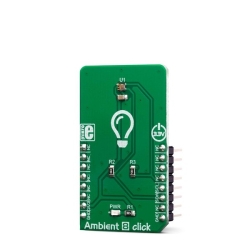
Stock and Customer Discounts
Available Discounts
- $9.45 | 25+ units
- $8.96 | 100+ units


